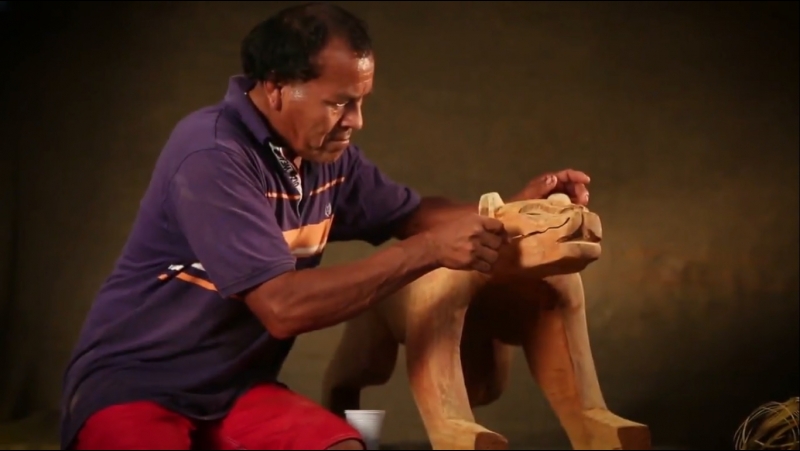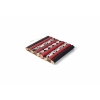Artist Kawakanamu Mehinaku Tells His Story
2018/11/21


Artist Kawakanamu Mehinaku gave us an account of his
relationship with art throughout his life:
“My
name is Kawakanamu Mehinaku, and I was born in the Xalapapühü village on April 10th,
1962. I am an artist in design and aesthetic of wood stools used for seating,
and a specialist in the making of handcrafted pieces, such as baskets,
feathered art, and necklaces. I have been living for the past four years at the
Kaupüna village, located at the Xingu National Park.
The
first piece I learned to make was a basket made out of buriti stalk,
when I was fifteen years old. That’s why I am a specialist in basketmaking. At that
time, I hadn’t learned how to sculpt stools due to the small number of people
that used to dedicate themselves to the production of this kind of art.
In the Xalapapühü village, I began to
sculpt a sparrow-hawk-shaped stool without anyone’s help, and I also dedicated
myself to making traditional shaman stools and stools with bird shapes. At that
time, no one would learn how to make animal-shaped stools due to the lack of instruments.
It was hard to travel because the cities were far from the Xingu
National Park and the access to the roads was difficult. Sometimes, I would
follow and observe the works of other artists without the need for assistance,
and so I learned how to paint the stools with traditional graphisms using the
resin ink from the inga tree mixed with charcoal and water.
The first time I sold my works of art,
it was to a handicraft buyer called Verinha, an employee at the Artíndia store,
which was subjected to the National Indian Foundation [Funai, in the Portuguese
acronym]. The sale took place at the Leonardo Villas Boas Center, where artists
used to meet. It allowed me to buy belongings and utensils: big knife, hammer,
axe, fishhooks, file, bicycle, pans, and other products.
When I moved into the Uyaipiuku village,
I was able to travel easily to state capitals, such as Cuiabá, São Paulo,
Brasília, and Rio de Janeiro, bringing with me products for sale: stools,
paddles, wood masks, baskets to carry manioc, fishing baskets, scoops for beiju,
maces, humming instruments, string masks, tucum necklaces, bracelets, and other
pieces. And so, I developed my autonomy from the professional ability of sculpting
stools of various shapes and sizes, such as mammals, birds, and fishes. Through
that, I met clients of the stores, who started to order pieces for resale. The
tools available made the stool production and its practices way easier. Since we
were in need, I taught my children, Yatapi, Mayawari, Yaruru, and Penuan, how
to make these works of art so that they could follow in my footsteps.
The woods used in the stools are: ami (from the sandpaper tree family), kawüxüpehi (sandpaper tree) from clear fields and the savannah, tsiyaka (plant of the Euphorbiaceae family), and kĩpietü (from the Leguminosae Ormosia coccinea and Ormosia coarctata families). There are also plants from the Moraceae family, from high vegetation areas. In the Utawana
village, I used the mawayakuma wood,
which can be found at the shore forests of the Kurisevo River, lakes, and
lagoons.
According to my point of view, the
works of art I make come from my ancestors and represent my Mehinaku identity. So,
I am proud of being a genius native artist. I don’t need to study the
scientific knowledge, my learning comes from my dedication to the practice.
I am publicly announcing my point of view so that Brazilian society can value and recognize indigenous artists, as well as its works of art. Each indigenous tribe has its own art product, which characterizes the identification of symbols from a certain people. In general, I ask all who have an interest in our products to pay fair prices, because the pieces originate from our ancestors and are used in our everyday routine.”
See too
Exposicao Itinerante Bancos Indigenas do Brasil - Grafismos
2025/03/20
Exposição Itinerante Bancos Indígenas do Brasil: Rituais em ManausConvidamos você a v...
Read moreApoie estudantes indígenas
2022/09/23
sua próxima Havaianas pode virar bolsas de apoio para estudantes indígenas.Agor...
Read moreSupport the Indigenous Peoples of the Xingu During Quarantine
2020/07/01
Help with the distribution of medicine, hygiene products and supplies to the Xingu In...
Read more











